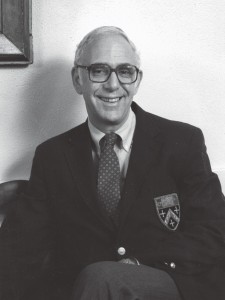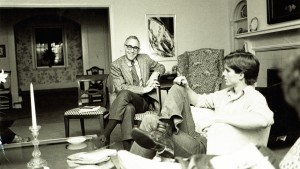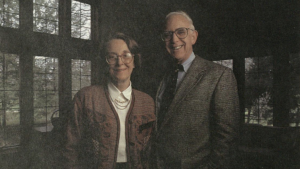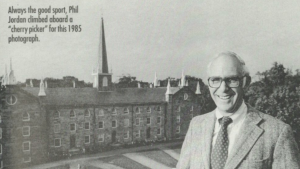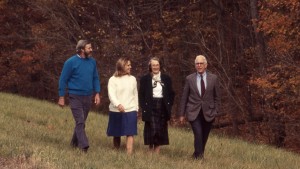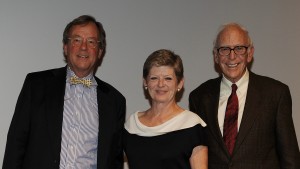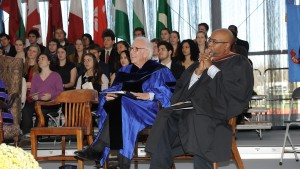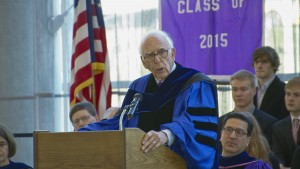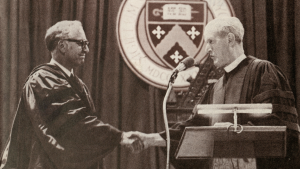“The great transformation Phil Jordan wrought at Kenyon has no memorial in facades of sandstone or brick,” said Perry C. Lentz ’64 H’09, who retired from Kenyon as Charles Pettit McIlvaine Professor of English, “but it was as significant and important as any achieved by the other great presidents who followed in William Foster Peirce’s wake. Before Phil arrived, Kenyon had a way of presenting itself to faculty candidates that suggested that, to make a career here, they must set aside or put in abeyance the deep inspirations and interests which had led them to a particular discipline to begin with, and which had then produced the record that had brought them to the College’s attention. We were intimating that we sought one-dimensional brilliance; we relied upon the ‘old-boy network’ and our impressions of their capacity as classroom teachers.
“At the outset of his tenure,” Lentz continued, “Phil gave the faculty an address entitled ‘The Lectern and the Lamp.’ At the lectern, he said, we were all excellent, but we had allowed our lamps, our careers as scholars or artists or researchers, to dim. Locked into that self-conception, Kenyon, he said, could never attract to itself a faculty as diverse, talented, brilliant, and renowned as everything else about the College promised that it could. He set about changing that, in which undertaking his great virtues of vision, friendliness, self-assurance, humor — especially that, and his laugh was famous — and his absolute absence of personal rancor or anger or egocentricity were crucial. And the result of that undertaking has been successful beyond anything of which I could have ever in my most optimistic moments conceived. Exactly as he envisioned, the more radiant the light from the lamp, the more — not the less! — radiant the presentation from the lectern.
“The true, priceless, and enduring legacy of Phil Jordan’s presidency is to be found in the extraordinary devotion, morale, pedagogical ability, and scholarly renown of the Kenyon faculty today, for which the College is not only famous but much envied.”
Linda D. Metzler H’17, professor emerita of Spanish, remembered, “I first met Phil when, in the spring of 1979, he interviewed me for a tenure-track position in Spanish — the College’s second. Phil’s gracious reception — his personal warmth, attentiveness as a listener, and sincere interest in my pursuits — helped to calm my nervousness and made Kenyon seem an attractive destination. Over ensuing years, I came to value other traits key to Phil’s success as a College president: his innate reasonableness, a commitment to dialogue, fidelity to a vision of greater social justice, a sense of humor, a tremendous capacity for hard work, and the determination to use scarce resources wisely.
“In his support of certain programs and initiatives close to my area of expertise — the expansion of the modern languages, curricular offerings in Latin American history at a time when such offerings were unusual in a liberal arts setting, the remarkable Great Lakes Colleges Association study-abroad program in Bogotá, Colombia, Kenyon faculty members’ stints teaching at the American University of Beirut, and the international studies concentration, Phil shaped an institution that drew the kinds of students I was eager to teach. In Kenyon classes, through study-abroad, and throughout subsequent careers, these students would pursue connections across borders, between languages, and among ways of thinking, ideologies, and religions.”
Metzler, who became friends with Sheila Jordan through their shared love of poetry and their commitment to the Ohio Poetry Circuit, noted that she kept in touch with the Jordans over their years on Chebeague. “I was repeatedly struck by how this couple never stopped learning, never stopped fostering activities aimed at illuminating the area’s history and poetry. And they were always organizing well-attended discussion groups for their neighbors on such subjects as the Civil War, the poetry of old age, and the Vietnam War.”
Browning, Lentz, and Metzler were among several faculty members and others in the community with whom Jordan developed close friendships over the years. Perhaps foremost among these was his relationship with the late religious studies professor Donald Rogan H’99, Kenyon’s one-time chaplain and longtime counselor. Rogan’s colleague and friend Royal Rhodes, who held the Donald L. Rogan Professorship in Religious Studies before his retirement, recalled, “Phil saw Don as someone with whom he could have confidential conversations about what was going on at the College. And Don meticulously kept what churchmen might call ‘the seal of the confessional.’
“I think Don was someone Phil trusted deeply and who had the respect of students, faculty, staff, and alumni,” said Rhodes. “He was to Phil more than part of a ‘kitchen cabinet’; he was someone who could be relied upon to speak the truth, even in situations that were awkward or critical. And Don greatly appreciated that trust in whatever matters they discussed.”
On a more personal note, Rhodes remembered, “I saw Phil as someone deeply shaped by the academic tradition. But for him tradition was not some static, backward-looking thing; it was a dynamic and creative grounding to help guide and order future progress. One area of progress was definitely in the continuing work of transforming the ‘old boy’ Kenyon into a truly supportive coeducational institution. And he did these things without personal fanfare, always placing the College and its mission first and foremost.”
“Phil did a number of marvelous mitzvahs as president of Kenyon that were hidden from public view,” remembers Peter Rutkoff H’21, recently retired professor of American studies and a faculty member throughout Jordan’s presidency. “I wish to recognize these, because they saved lives and careers. Phil acted out of a basic humane response to need and out of clear compassion for others. In three examples I know of first hand, he responded without fear of political effect and without any need to claim personal credit. These were right actions, and I praise Phil’s memory for them.”
“I had the pleasure of working with Phil for his entire tenure as president,” recalls Douglas L. Givens H’10, Kenyon’s former vice president and the first managing director of the College’s land trust. “He was the model of a college president, whip smart and — even though he came out of the academic world — incredibly practical. He was a top-notch fundraiser and learned quickly the value of fiscal responsibility.
“I took Phil on his first road trip to meet alumni, parents, and friends,” Givens remembers. “We were at the University Club of New York and the place was packed. Phil took to the podium and spoke for 45 minutes. The audience was in awe. Phil and I had a nightcap after the long evening, and I told him that his talk was one of the best I’d ever heard. I suggested that if he would give me the text I would see it was published in the next alumni magazine. He smiled and handed me a three-by-five index card with five words on it!
“Phil and Sheila loved this place,” Givens said. “And he and Sheila left it in far better shape than they found it. I shall miss him greatly.”
Jordan’s skill as a fundraiser came at a time when it was much needed. He played a key role in gaining numerous gifts to the College from leading foundations to meet Kenyon’s existing needs and to support a range of new initiatives. The most critical of these was the record-breaking $5.5-million gift from the Franklin W. Olin Foundation for the construction of a new library. (Alas, that library, which served the College for 30 years before its demolition, had what Perry Lentz aptly described as “the shortest shelf-life of any library erected before the full onset of the digital age.”)
In 1984, the College launched its first comprehensive capital fundraising effort, the “Campaign for Kenyon.” While its goal of $35 million seems quaint by current standards, it marked a major step forward for the College in challenging its constituencies to contribute to the institution’s financial health. As Jordan himself, who was the face of the campaign, noted, “Both on campus and off, members of the Kenyon family contributed unstintingly of their time and energy, as well as their funds, to transform the visions of the campaign” — which included scholarship endowments and faculty chairs — “into realities.”
The chief finance officer with whom Jordan worked for much of his tenure at the College was Joseph G. Nelson H’16, who retired as vice president in 2016. “When I think of Phil,” said Nelson, “I think of a president who knew where Kenyon was in the world of academia when he started and who knew exactly where he wanted to take the College and how to get there. He was determined to set the table for his successor to excel, and that’s precisely what he did.
“Phil left the office of president with Kenyon being far better off than when he arrived there. Better in academic reputation, better in student profile, and, near and dear to my heart, better in financial condition. I feel very fortunate to have worked at the College for almost all of his 20 years as president. It was fun!”
Cornelia “Buffy” Ireland Hallinan ’76 H’91, a Kenyon trustee emerita who was the first woman (and alumna) to chair the board, met Jordan when she was serving as a student member of the search committee that eventually brought him to the College. “Phil had a personality made for a presidency,” she recalled. “He had a way of asking for information quite humbly, digesting it, and then confidently announcing his decision.”
Hallinan noted that as the first president of a Kenyon with four classes of women, Jordan was able to rely on his experience at Connecticut, where the college had gone from all female to coeducational during his tenure. More importantly, she said, he had real sensitivity to the particular needs of women in the student body, a reflection of the mutual support and respect that characterized his marriage, as well as a firm commitment to bringing more women onto the faculty.
“Phil was also proud that he was able to work with the board to restart the Kenyon Review,” said Hallinan, referencing the College’s signature publication, which had ceased publication in 1970. “The path may have been uncertain, yet there was no question where it would lead.”
Hallinan credits Jordan with encouraging her to become a leader on the board. “Phil was a generous mentor who, along with Sheila, became a great friend. I wouldn’t have achieved what I did while on the board without his help in the beginning.”
Jordan announced in 1994 that he would be retiring at the end of the 1994-95 academic year. Both he and Sheila Jordan were awarded honorary doctorates at the 1995 Commencement, with the citation for his doctorate in humane letters presented by then-board chair John B. McCoy H’94. That citation read, in part, “Your love for the College, your sensitivity to the importance of its traditions, your understanding of both its strengths and its needs, your willingness to listen and to seek the counsel of others, and your boundless energy and enthusiasm have impressed us all. What we can now call the ‘Jordan era’ at Kenyon represents a period of remarkable vitality, growth, and enrichment, during which our heritage from the past has been preserved and enhanced while, at the same time, dramatic advancement has been made.”
To give further recognition to the Jordans, Dr. and Mrs. Andrew Thomson P’76 and the Beatrice DeLany Charitable Trust made a $1.25-million gift to the College to create a new professorship in their name. The Philip and Sheila Jordan Professorship in Environmental Studies, which has been a boon to Kenyon’s biology department and to its program in environmental studies, has been held by E. Raymond Heithaus ’68 H’14 and Siobhan Fennessy, its current incumbent.
After his retirement from the College, Jordan continued his involvement in education. He served first, and soon after leaving Kenyon, as the interim head of school at the Lawrenceville School, where he had earlier served as a trustee. In 2005, he accepted an appointment as interim president at Colby-Sawyer College, which had previously been headed by Anne Ponder, a former academic dean and interim vice president for information technology at Kenyon.
Full retirement took the Jordans to a house they had built to their specifications on Chebeague, an island long known to Sheila Jordan and her family. A return visit to Gambier came in fall 2011, when Phil Jordan participated in a lively panel discussion, “Three Presidents at Kenyon,” with his successors Robert A. Oden Jr. and S. Georgia Nugent H’13 in the then-new Community Foundation Theater in the College’s Gund Gallery. The free-flowing conversation was frequently interrupted by the participants’ laughter, the most distinctive of which was Jordan’s inimitable and joyous roar.
Jordan is survived by his wife, Sheila Gray Jordan; two sons, Philip Harding Jordan III, a faculty member at Lawrenceville, and John Gray Jordan, a lobsterman and a founder of Calendar Islands Maine Lobster Company; and six grandchildren.
Memorial contributions may be made to Kenyon College; the Lawrenceville School, or the Chebeague Island Historical Society. A memorial service at Lawrenceville, as well as a gathering on Chebeague, will be scheduled for the fall.
The Kenyon flag has been lowered to half staff in Jordan’s memory.
